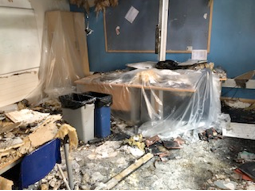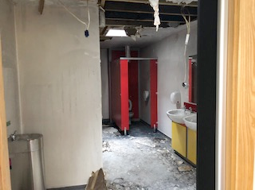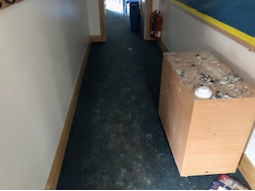The Brief
The client is an independent prep school for boys aged between 4–13 years of age, based in Twickenham, south-west London. When a fire broke out in the extractor fan of the toilets, the need for water damage clean up was caused by firefighting efforts.
We attended site to advise on the best drying methods and to establish the levels of damage caused by not only the fire extinguishing attempts, but also from rain coming through the roof.
The Objective
A fire started in the extractor fan of the toilets. The fire brigade attended and there was water damage to the property as a result. Rainwater entered through the roof and caused further water damage.
Ceilings collapsed under the weight of the water, with the ceilings in the toilets and club room damaged beyond repair.



The walls (constructed by stud partition and plaster in most rooms, while others are blockwork and plaster) were wet and required drying. The floor slabs were also wet as these areas had been subjected to abnormal amounts of water ingression. The ground floor construction consists of carpet tiles, floor screed, a concrete base, insulation, DPM (damp proof membrane), and hardcore. Some areas also had moisture barriers.
Founded in 1872, the prep school for boys is built primarily of brick with a pitched timber frame roof, finished with tiles.
The Technical Part
Upon arrival to site, our technicians carried out enabling work to ensure that the area was safe for occupants of the building, and for them to work in. Cross-contamination procedures were also put in place to avoid any mould spores or contaminated water from spreading to previously unaffected areas.
The affected ceilings in the toilets and club room required a complete strip out and all wet carpet tiles needed to be lifted. Skirting board in the affected rooms was also removed, along with affected plasterboard.
Floor coverings have to be lifted in order to facilitate the drying process and ensure no trapped moisture is left underneath. Microbial growth, namely mould, can quickly grow on organic building materials such as plasterboard, and Gypsum plasterboard should be replaced if it shows signs of bowing or delamination.
Environmental conditioning was completed to stabilise the internal conditions. After water damage such as what happened at The Mall school, excess water vapour can encourage mould growth and also cause wall and floor finishes to delaminate (referred to as secondary damage). The aim of this procedure is to establish a normal level of Relative Humidity and remove any airborne particulates to reduce the likelihood of further damage.
Once the strip out work was complete, the affected areas were sanitised, cleansed and rinsed, to reduce micro-organisms and airborne particulates which may still be present following the initial decontamination.
Finally, desiccant dehumidifiers were installed and the areas tented off to target dry the floor slabs in the affected rooms. Desiccant dehumidifiers were also installed in the toilet and the ceiling tented off using plastic sheeting to ensure the most efficient drying environment was created.
The drying process took two weeks to complete.



